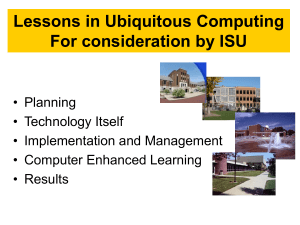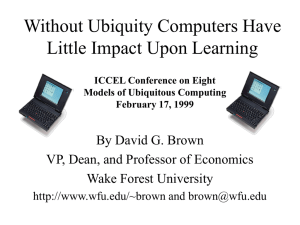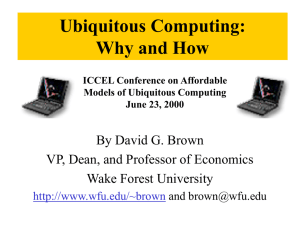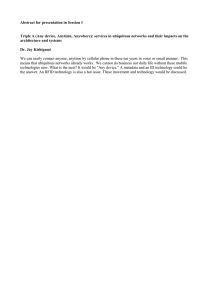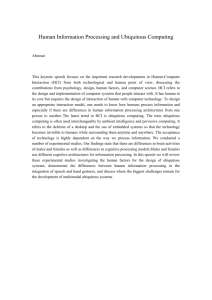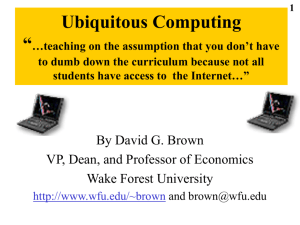Lessons Learned by Ubiquitous Computing Universities Higher Education
advertisement
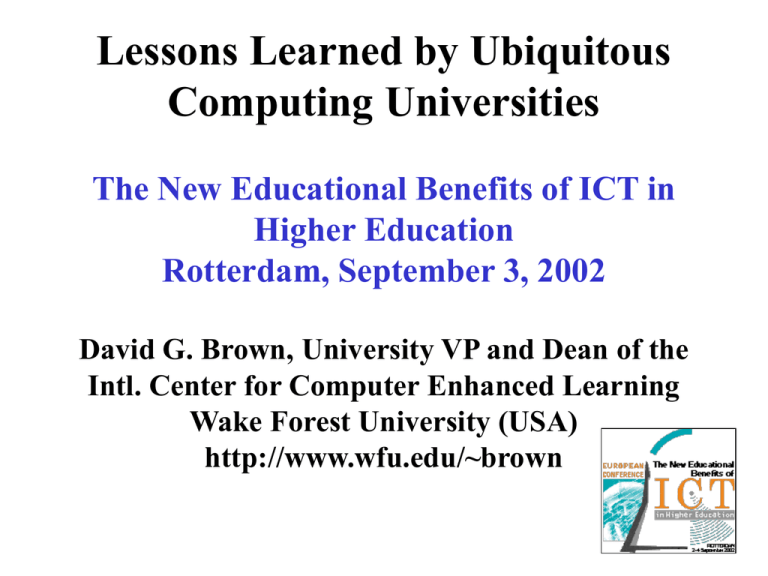
Lessons Learned by Ubiquitous Computing Universities The New Educational Benefits of ICT in Higher Education Rotterdam, September 3, 2002 David G. Brown, University VP and Dean of the Intl. Center for Computer Enhanced Learning Wake Forest University (USA) http://www.wfu.edu/~brown 2 Ubiquitous Computing Defined “all teaching proceeds on the assumption that all students and faculty have appropriate access to the internet” 3 http://www.vcsu.nodak.edu/offices/itc/notebooks/other.htm 4 Hierarchy of Ubiquity • • • • • • • • • All “Own” Identical Laptops + 2-Year Refresh All “Own” Identical Laptops All “Own” Threshold Laptops All “Own” Identical Desktop Computers All “Own” Threshold Computers All “Own” Network Computers All Have Access to Threshold Computers All Have Access to Public Computer Labs Teach with Explicit Assumption of Access 5 • • • • • • • 3700 undergrads 92% residential 1300 average SAT 500 each: Med, Law, MBA, PhD $900M endowment 26th in US News & World Report Rhodes Scholars THE WAKE FOREST PLAN IBM A30, Pentium III, 1.13GHz Processor, 30GB Hardrive, 384 MB RAM 15”ActMatrix Screen, CD-RW/DVD, Floppy, 56k modem, 16MB Video Ram, 10/100 Ethernet, USB&Serial&Parellel&Infrared Ports • • • • • • • • • • IBM Laptops for all Printers for all New Every 2 Years Own @ Graduation 31.000 Connections Standard Software 99% E-Mail Start 1995, 4 Year Phase In +15% Tuition for 37 Items +40 Faculty and 30 Staff Standard Load Includes— MS Office, Dreamweaver, SPSS, Maple, Acrobat, Photoshop, Shockwave, Flash, Net Meeting, Real Producer & Player, Media Player, Windows XP Moviemaker, Apple QuickTime, Netscape & Explorer, Netscape Calendar & Communicator, Windows XP Professional 6 Lessons Learned by Ubiquitous Computing Universities Rotterdam, September 3, 2002 David G. Brown, Wake Forest University http://www.wfu.edu/~brown 1. 2. 3. 4. Instructions: On each slide Circle 1 or 2 of the most important/useful ideas (no more than 2)! Strike the least important or least valid idea. Add an idea not on the list Be prepared to report to the rest of us 7 Lessons Re Planning for Ubiquitous Computing 8 1. Don’t lose sight of the ultimate goal: measurable improvement of education outcomes. Keep the focus on pedagogy, not technology. Remember that students are the center of the program: everyone else is important, but the program serves the students directly. Stay focused on the goal of enhanced student learning. 2. Clearly defined, defensible program objectives are essential. 3. Develop a comprehensive plan first and quickly match it with a multiyear financial plan. Establish a clear financial plan and budget and a mechanism for revising the budget annually. Include adequate startup and operating funds. 4. Demand for technology will increase much faster than anticipated. 5. Most sunk costs (for example, old computers) can be ignored. Lessons Re Planning for Ubiquitous Computing 9 6. Getting laptops to students is only 10% of the challenge; decisions about, and implementation of, policies, training, support, networking, exposure, and motivation remain ahead. 7. Recognize that user-friendly technology in the hands of dedicated faculty is the most powerful change instrument that any academic administrator has ever had. 8. Top executive support is essential. 9. The impact of computing on teaching and learning is difficult to assess objectively. 10. Disciplines use the computer in different ways, so a broad spectrum of faculty must participate in system design decisions 10 Lessons Re the Technology Itself 1. Reliability is crucial, esp. a robust network & trained help desk. 2. Standardize on hardware, software, and ISP at least at first. Standardization pays rewards well beyond those anticipated. 3. Pay attention to the logistics of distributing equipment: it’s harder than you think. Laptop distribution is a major production: define each step and automate everything possible. 4. Don’t accept the first bid from a vendor: the market is competitive, and vendors will improve their bids. Develop strategic partnerships rather than just buying from vendors. Choose a partner for the long haul. 5. Models and prices change fast: don’t buy too early in the year and then be forced to deliver a discontinued model to your students, while they read ads in the newspaper for new machines at fire-sale prices. 11 Lessons Re the Technology Itself 6. Sign procurement contracts with major vendors specifying their responsibilities for delivery and for equipment that fails initially or repeatedly. 7. Technology will sometimes fail. 8. Have a structure for student repairs. 9. You can never have enough bandwidth to the Internet or network disk space. 10. One of the biggest financial challenges is what to do with laptops used for a semester or two and returned when a student withdraws or is dismissed. 11. The help desk must be close to classrooms. 12. Wireless is worth it: don’t hesitate too long, and be complete with your wireless coverage. Lessons on the Implementation and Management of Ubiquitous Computing 12 1. Professional project management is essential, especially during startup. 2. Be prepared to outsource challenges; consulting help is essential. 3. Use commercial course management software. 4. Spread the gains from, and ownership of, innovation throughout all units. Identify and incorporate existing assets before creating new ones. 5. Balance central services and local control. Lessons on the Implementation and Management of Ubiquitous Computing 13 6. Provide academic units staff of their own and plenty of equipment without hassle. 7. Put in place an ongoing faculty and student-led oversight mechanism to monitor and to adjust the program. Place some funds under faculty control. Apply academic review structures to the program. Don’t let administrators have control of faculty development. 8. Understand the role of standards in the program, and obtain agreement on them from faculty and administration. 9. Ultimate responsibility should be given to a senior administrator with the authority to set directions and settle disputes. 10. Never underestimate the power of teamwork. Lessons on the Implementation and Management of Ubiquitous Computing 14 11. Involve parents as early as possible. 12. Hardware and software decisions are separable. 13. Communicate, communicate, communicate frequently with all stakeholders. 14. Manage expectations; they invariably outrun the capacity to deliver. Address faculty and student concerns truthfully, adequately, and quickly in order to quell rumors. Keep your admissions office informed. Regularly reconcile program descriptions in university publications with those on the Web. 15. High percentages of faculty will use the computer if their initial introduction involves only email, URL addresses, and course materials posted by a course management system. Lessons Re Adoption of Computer Enhanced Learning 15 1. Plan a Pilot Year to purge bugs when stakeholders will still tolerate imperfections. 2. Provide students and faculty just-in-time training that centers on the task-at-hand; general classes don’t work well. 3. In a standardized environment, students learn basic computer skills quickly, without degree-credit incentives. 4. Standardization speeds faculty adoption and eases the pressure on support staff. 5. First encourage easily learned and administered uses of the computer by a high percentage of faculty; leave the more difficult and expensive uses of the computer until later 6. Early academic involvement and leadership is critical to success. 7. Make use of student expertise to support peers and faculty. Lessons Re Adoption of Computer Enhanced Learning 16 8. Student access to computing can vary even in a highly standardized environment. Students aren’t all computer wizards. Some can be archly conservative. 9. Coordinate the technology program with existing programs for faculty development and training. 10. Continue, long after program launch, to provide faculty training. 11. Recognize that it’s quite possible to launch an online course for less than $30,000. 12. Avoid minimum expectations about the amount and character of technology to be used in individual courses. 13. Find opportunities for faculty to showcase the results of their work. 14. Develop an intellectual-property policy that benefits both individuals and the university. 17 Lessons on Results 1. Contact among students and between students and faculty becomes continuous. 2. Students teach faculty, and friends serve as an informal help desk. 3. Co-curricular activities thrive due to increased communication. Student groups are larger and more active. 4. Team assignments are more frequent and more easily completed. 5. Computer knowledge is a boon to student recruitment, retention, and self-confidence. 18 Lessons on Results 6. Computer availability throughout the student body attracts new faculty. 7. The greatest benefits are seen in what happens between classes, not during class. 8. If students are provided a standard platform with a standard software load, faculty will voluntarily and rather quickly migrate toward the same standard. 9. Student presentations are more substantive and polished. 10. Student preservation of electronic materials is greatly facilitated by rewritable CDs and a program for creating portfolios. 19 David G. Brown Wake Forest University Winston-Salem, N.C. 27109 336-758-4878 email: brown@wfu.edu http//:www.wfu.edu/~brown fax: 336-758-5012 ICCEL -- Wake Forest University, 2002
